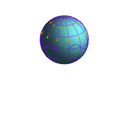

Astronomy 162: Professor Barbara Ryden
In the 1920's, Edwin Hubble uncovered the Hubble Law, which states that distant galaxies are receding from us with a speed proportional to their distance. As I mentioned in the lecture for Tuesday, February 25, this observational result implies that the universe is expanding uniformly.
We see distant galaxies all moving away from us. This does not imply that we are at the center of expansion. In uniform expansion, every galaxy sees all the other galaxies moving away. (Consider, as an analogy, an expanding loaf of raisin bread. As the loaf expands, the distance between every pair of raisins increases. Thus, each raisin -- if you can imagine a raisin with eyes -- sees all the other raisins moving away from it.) The expansion of the universe has no center. As far as we can tell, the universe has no edge, either. (This is where the ``raisin bread'' analogy breaks down; there is no crust or boundary to the universe.)
Please note, as a clarifying point, that you are not expanding with the universal expansion. You are strongly bonded together by electromagnetic forces. Our galaxy is not expanding either; it's strongly bonded together by gravitational forces. It's only on large scales -- scales larger than clusters of galaxies -- that the universe is expanding.
What do I mean when I talk about a ``cooling universe''?
Consider, as an example, blackbody radiation from a star
in a distant galaxy. The star's temperature is identical
to that of the Sun: T=5800 Kelvin. Thus, the wavelength
of maximum emission is 500 nanometers (well within the
range of visible light). As the universe expands, however,
the wavelength of light traveling through the universe
expands as well.

For instance, if distances double due to the
universal expansion, the light from the
distant star will be doubled in wavelength. The
wavelength of maximum emission will then be 1000
nanometers (in the infrared). The starlight will
be cooled, therefore, to a temperature of 2900 Kelvin,
half its initial temperature of 5800 Kelvin.
The redshift of distant objects, due to the universal
expansion, is called the cosmological redshift.
The observed cosmological redshift of a galaxy tells us how much the universe has expanded since the light we observe was emitted. Consider, for instance, a galaxy with a redshift z=1. The wavelength of the galaxy's light has doubled since it was emitted. Thus, a galaxy with a cosmological redshift z=1 is seen as it was when distances between galaxies were half their present value (and hence were more likely to interact and merge with each other).
If no forces have been acting on the galaxies, and they've just been coasting freely apart at a constant speed, then the time required for the expansion of the universe is equal to one over the Hubble constant.
If H0 = 70 km/sec/Mpc (the best current value) then 1/H0 = 14 billion years. (This is just an approximation, of course. If gravity has been slowing the expansion, the universe took less time than this to expand. If some force is currently speeding up the expansion, the universe took more time than this to expand. But it's a good approximation to start with.)
The universe is not infinitely old. The ``Big Bang'' (that is, the explosion that marked the beginning of the expansion) happened about 14 billion years ago. Because the universe is about 14 billion years old, we can't see objects more than about 14 billion light-years away. The light from them simply hasn't had time to reach us yet. As a consequence of the universe's finite age, we are surrounded by a horizon (technically referred to as the ``cosmic particle horizon'') beyond which we cannot yet see. The universe may well be infinite in extent, but we can only see a finite patch of it. The existence of the cosmic particle horizon explains why the night sky is dark. (If the universe were infinitely old, and stars had been shining all that time, then everywhere we looked we would see a star -- the whole sky would look as bright to us as the surface of the Sun.)
The ``Big Bang Theory'' states that the universe was initially very hot and dense, and is currently expanding. This theory is supported by a wide array of observational evidence (we'll be examining some of it in the remaining lectures). The Big Bang Theory also poses many questions which cosmologists are still pondering. For instance:
Updated: 2003 Feb 4
Copyright © 2003, Barbara Ryden